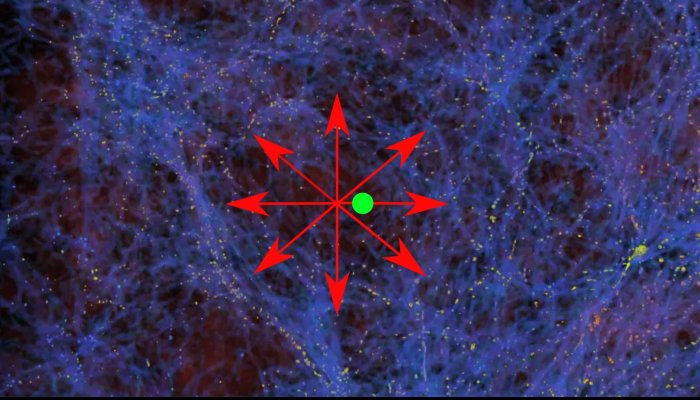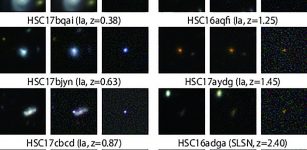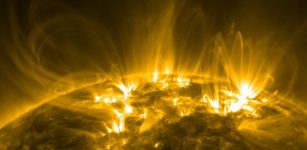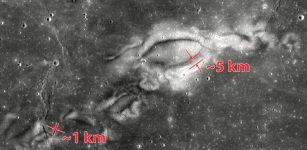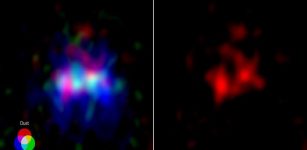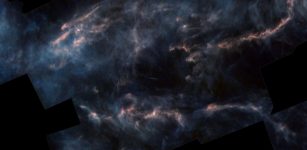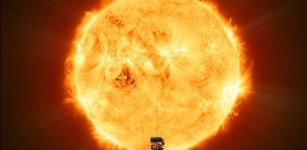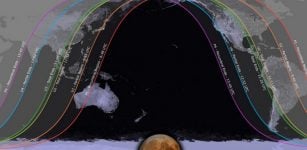Hubble Tension: A New Possible Explanation For An Intriguing Problem In Cosmology
Eddie Gonzales Jr. – MessageToEagle.com – The universe’s expansion causes the galaxies to move away from each other.
The speed at which they do this is proportional to their distance. For instance, if galaxy A is twice as far away from Earth as galaxy B, its distance from us also grows twice as fast. The US astronomer Edwin Hubble was among the first to recognize this connection.
The image shows the distribution of matter in space – (blue; the yellow dots represent individual galaxies). The Milky Way (green) lies in an area with little matter. The galaxies in the bubble move in the direction of the higher matter densities (red arrows). The universe therefore appears to be expanding faster inside the bubble. Image credit: AG Kroupa/University of Bonn
In order to calculate how fast two galaxies are moving away from each other, it is therefore necessary to know how far apart they are. However, this also requires a constant by which this distance must be multiplied. This is the so-called Hubble-Lemaitre constant, a fundamental parameter in cosmology. Its value can be determined, for example, by looking at the very distant regions of the universe. This gives a speed of almost 244,000 kilometers per hour per megaparsec distance (one megaparsec is just over three million light years).
244.000 kilometers per hour per megaparsec – or 264,000?
“But you can also look at celestial bodies that are much closer to us – so-called category 1a supernovae, which are a certain type of exploding star,” Prof. Dr. Pavel Kroupa from the Helmholtz Institute of Radiation and Nuclear Physics at the University of Bonn explains in a press release.
It is possible to determine the distance of a 1a supernova to Earth very precisely. We also know that shining objects change color when they move away from us – and the faster they move, the stronger the change. This is similar to an ambulance, whose siren sounds deeper as it moves away from us.
If we now calculate the speed of the 1a supernovae from their color shift and correlate this with their distance, we arrive at a different value for the Hubble-Lemaitre constant – namely just under 264,000 kilometers per hour per megaparsec distance. “The universe therefore appears to be expanding faster in our vicinity – that is, up to a distance of around three billion light years – than in its entirety,” says Kroupa. “And that shouldn’t really be the case.”
However, there has recently been an observation that could explain this. According to this, the Earth is located in a region of space where there is relatively little matter – comparable to an air bubble in a cake. The density of matter is higher around the bubble. Gravitational forces emanate from this surrounding matter, which pull the galaxies in the bubble towards the edges of the cavity. “That’s why they are moving away from us faster than would actually be expected,” explains Dr. Indranil Banik from St. Andrews University. The deviations could therefore simply be explained by a local “under-density.”
In fact, another research group recently measured the average speed of a large number of galaxies that are 600 million light years away from us. “It was found that these galaxies are moving away from us four times faster than the standard model of cosmology allows,” explains Sergij Mazurenko from Kroupa’s research group, who was involved in the current study.
Bubble in the dough of the universe
This is because the standard model does not provide for such under-densities or “bubbles” – they should not actually exist. Instead, matter should be evenly distributed in space. If this were the case, however, it would be difficult to explain which forces propel the galaxies to their high speed.
“The standard model is based on a theory of the nature of gravity put forward by Albert Einstein,” says Kroupa. “However, the gravitational forces may behave differently than Einstein expected.” The working groups from the Universities of Bonn and St. Andrews have used a modified theory of gravity in a computer simulation. This “modified Newtonian dynamics” (abbreviation: MOND) was proposed four decades ago by the Israeli physicist Prof. Dr. Mordehai Milgrom. It is still considered an outsider theory today. “In our calculations, however, MOND does accurately predict the existence of such bubbles,” says Kroupa.
If one were to assume that gravity actually behaves according to Milgrom’s assumptions, the Hubble tension would disappear: There would actually only be one constant for the expansion of the universe, and the observed deviations would be due to irregularities in the distribution of matter.
Original story – University of Bonn via Eurekalert
Written by Eddie Gonzales Jr. – MessageToEagle.com Staff Writer

